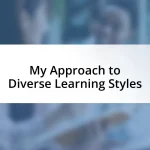Key takeaways:
- Understanding the emotional experiences and backgrounds of reluctant learners is crucial to addressing their barriers to motivation.
- Creating a supportive environment with active listening, encouragement, and flexibility fosters a sense of safety and belonging for students.
- Incorporating engaging teaching methods, such as game-based learning and storytelling, can captivate reluctant learners and make lessons more relatable.
- Setting achievable goals and celebrating small successes boost confidence and motivation in students, encouraging their ongoing engagement in learning.
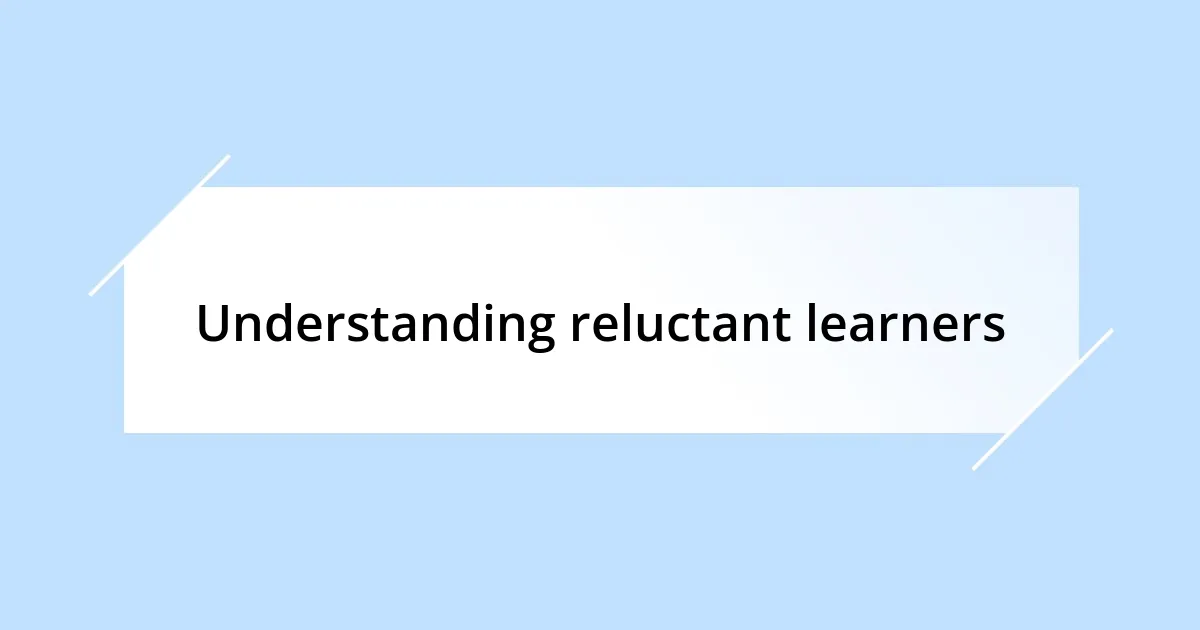
Understanding reluctant learners
Understanding reluctant learners often requires delving into their individual experiences and backgrounds. For instance, I recall a student named Jake, who struggled with math because he felt that previous failures had robbed him of confidence. When I took the time to listen to his story, it became clear that his reluctance stemmed not from a lack of ability, but from fear of failing once more.
Have you ever considered how emotional experiences shape a learner’s attitude toward education? For many reluctant learners, negative past encounters can create a barrier that seems insurmountable. I’ve seen students walk into a classroom, their shoulders slumped with the weight of past disappointments, making it imperative for us to approach them with empathy and understanding.
Another intriguing aspect is the idea of motivation itself. What drives these learners? I often wonder if, by tapping into their interests or passions, we can spark a desire to engage. For example, I once paired a reluctant reader with a graphic novel related to his favorite video game. Watching his eyes light up as he connected the dots felt like a breakthrough, highlighting the importance of tailoring our approach to their unique perspectives.
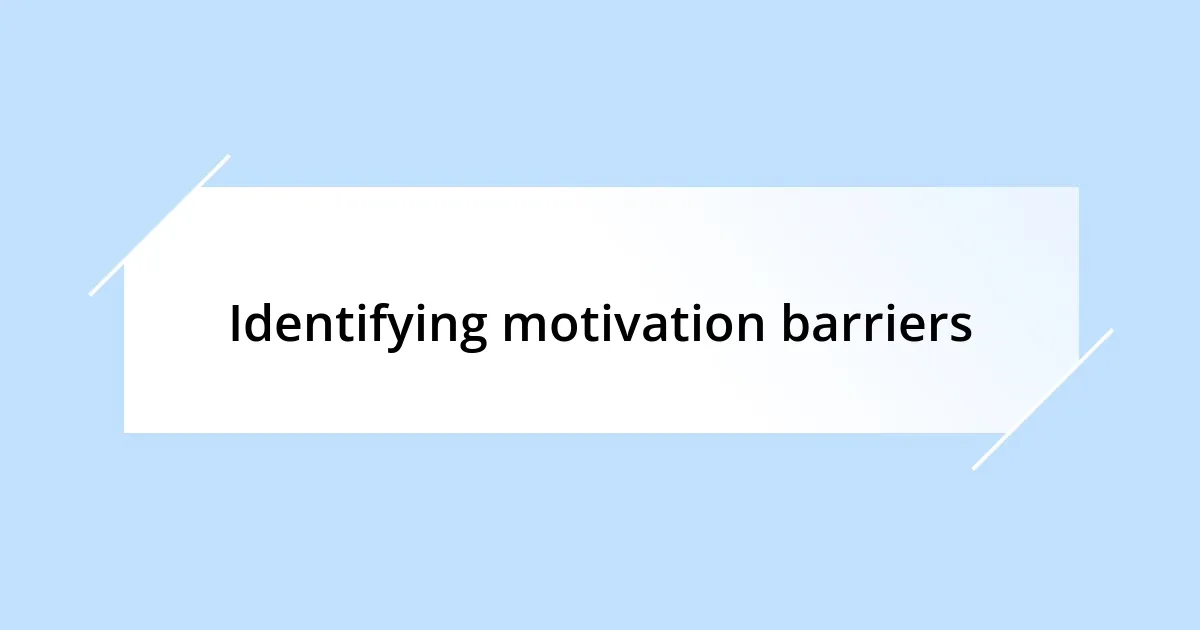
Identifying motivation barriers
It’s essential to recognize that motivation barriers can stem from multiple sources. I remember working with a young girl named Samantha, who consistently avoided group projects. After a heartfelt conversation, I discovered that she felt invisible among her peers, which crushed her confidence and made her disengage. Identifying this barrier was key; it wasn’t that she lacked the skills but rather that her social anxiety held her back from participating.
On another occasion, I encountered Thomas, a bright student who excelled in some subjects but struggled with writing. As I explored his thoughts, it became evident that he believed he wasn’t “creative enough.” This misconception created a mental block that stifled his potential. Identifying these misbeliefs is crucial in dismantling the barriers to motivation.
Lastly, the impact of external factors cannot be overlooked. I’ve seen how family dynamics, such as an overly critical parent or financial instability, can affect a learner’s drive. For example, when I worked with a student whose family was going through a tough time, his focus shifted entirely. Recognizing these real-life pressures can help us understand the reluctance and develop appropriate strategies to support those learners effectively.
| Motivation Barrier | Example from Experience |
|---|---|
| Emotional Issues | Samantha felt invisible, affecting her group participation. |
| Misbeliefs | Thomas thought he wasn’t creative, blocking his writing. |
| External Factors | A student’s family crisis diverted his focus entirely. |

Building a supportive environment
Creating a supportive environment is vital for helping reluctant learners flourish. I remember a classroom where I implemented a “no wrong answers” policy during discussions. It allowed students to share their thoughts without fear of being judged, fostering a sense of safety. Even simple gestures, like smiling or offering praise, can make a huge difference in helping these learners feel valued and included.
Some key elements I focus on include:
- Active Listening: I always ensure that students know their voices matter. When I nod while they speak, I can almost see their confidence grow.
- Encouragement: I often remind students that effort counts just as much as outcomes. When I celebrated small wins, I could see the spark of motivation ignite.
- Collaborative Activities: Group tasks that allow for diverse contributions help students connect with peers, reducing anxiety. Just last week, pairing a shy student with a more outgoing classmate resulted in unexpected teamwork and laughter.
- Flexibility: Sometimes, adapting the learning environment—such as allowing students to choose their seating or working conditions—has led to remarkable improvements in engagement levels. I’ve seen students come to life when given this freedom.
These approaches have allowed me to witness moments of breakthrough, reminding me just how transformative a supportive environment can truly be.

Using engaging teaching methods
Using engaging teaching methods can truly make a difference in reaching reluctant learners. For instance, I once tried incorporating game-based learning in my lesson plans. I created a quiz competition that generated excitement and participation from students who usually sat quietly in the back. To my surprise, the shyest kid in the class, who rarely spoke up, buzzed with enthusiasm. I couldn’t help but wonder—what if all lessons could feel this interactive?
Another strategy that works wonders involves storytelling. I often weave narratives into my lessons to connect concepts to real-life situations. I vividly recall using a story about a young inventor facing challenges, paralleling it to a complex math problem. The students’ eyes lit up as they connected emotionally. It’s fascinating to see how a simple tale can transform abstract concepts into relatable experiences that spark curiosity.
Moreover, I’ve found that integrating technology in a meaningful way can captivate even the most disinterested learners. For example, I once introduced a digital art project to illustrate scientific principles. The students not only grasped the content better but also showcased their creativity. They were genuinely excited about their work. Seeing their pride beaming as they shared their digital presentations made me realize: when learning feels relevant and fun, motivation follows suit.
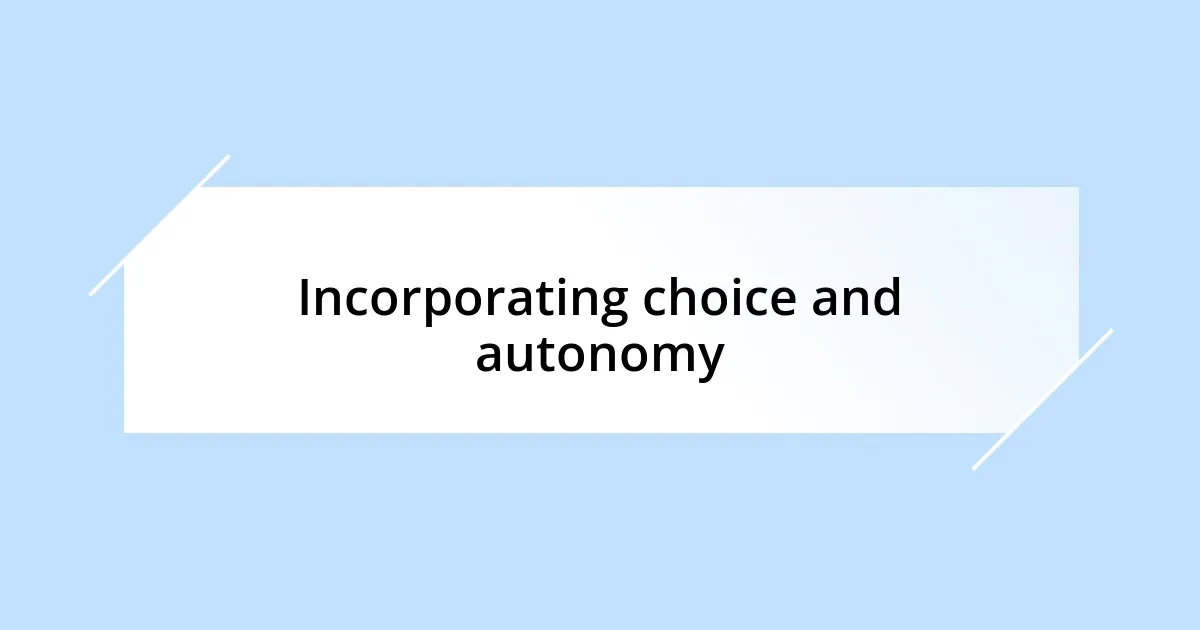
Incorporating choice and autonomy
Incorporating choice and autonomy into the learning process can ignite a spark of motivation among reluctant learners. I once allowed my students to select their project topics from a list I provided, and the difference was astonishing. Watching their eyes light up as they discussed their preferences reminded me that giving them a say can create genuine interest and investment.
When students feel a sense of ownership over their choices, they’re more likely to engage. I remember implementing a “choose your own adventure” reading unit where students picked the books they wanted to explore. This simple addition not only increased their participation but also fostered lively discussions as they shared their perspectives on the different stories. Who would have thought that just having options could turn disengagement into excitement?
Flexibility also plays a critical role in fostering autonomy. I recall a time when I encouraged my students to decide their group roles in a collaborative activity. Not only did this lead to a surge of creativity, but it also allowed students to play to their strengths. By trusting them to take the reins, I witnessed firsthand how empowered they felt in driving their learning experiences. Isn’t it fascinating how a little freedom can lead to profound engagement?
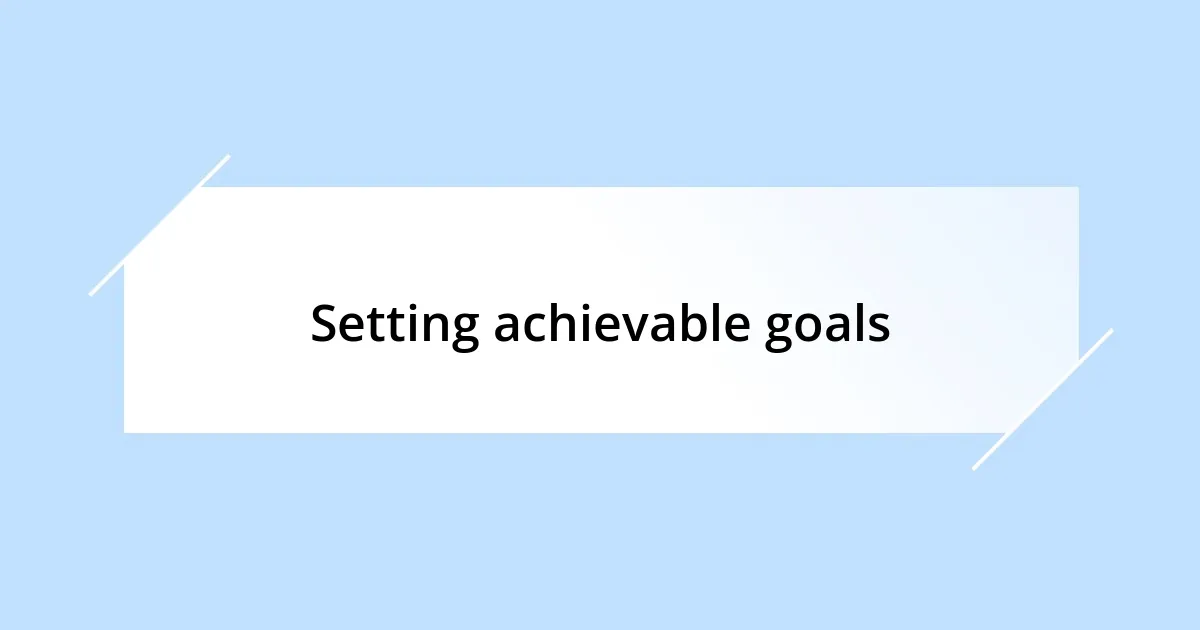
Setting achievable goals
Setting achievable goals is essential to helping reluctant learners find their footing. I often incorporate SMART goals—specific, measurable, achievable, relevant, and time-bound—into my teaching. For example, I once guided a student who was overwhelmed by tough math concepts to set a goal of solving three problems each day. The look of determination on their face when they achieved it was priceless, and that little victory built their confidence to tackle more challenging material.
I’ve found that breaking larger tasks into smaller, digestible steps can work wonders too. I remember a project where students designed a simple science experiment. Instead of overwhelming them with the entire process at once, I encouraged them to focus on one aspect per week. Listening to their relief when they realized they could master a small part before moving on was heartening. It made me think—why do we sometimes forget that progress is often made one step at a time?
Celebrating these small successes is equally crucial. I’ve taken to organizing mini-celebrations for each time a student meets a goal, whether it’s a sticker on their planner or sharing their accomplishment with the class. I’ve seen firsthand how recognition fuels motivation. It made me realize that sometimes, all a reluctant learner needs is that moment of joy to keep them pushing forward. After all, isn’t it amazing how a simple acknowledgment can transform a struggle into a stepping stone?
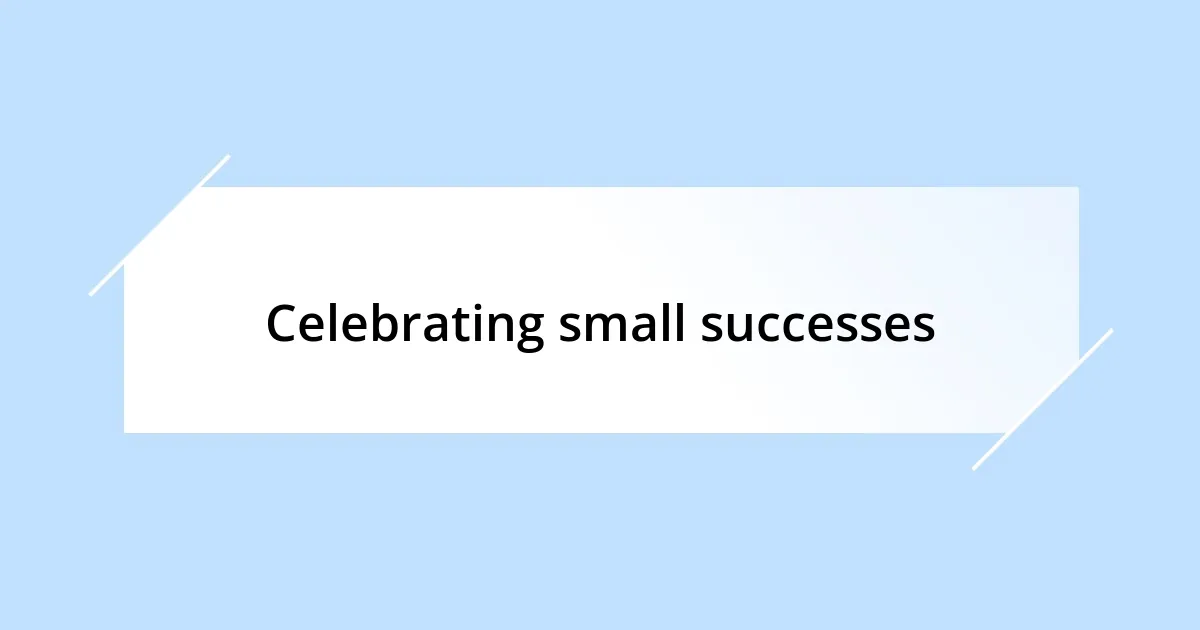
Celebrating small successes
There’s something truly powerful about pausing to celebrate small successes. I vividly remember a student, Jamie, who was hesitant to read aloud. After weeks of practice, he finally raised his hand during a group activity and read a paragraph without stumbling. That moment, though seemingly small, felt monumental. I organized a quick applause from the class, and the sheer joy on his face was unforgettable—like I’d unlocked a new layer of confidence within him. Don’t you think that these celebrations can create a ripple effect of motivation?
In my experience, the way we acknowledge achievements often matters just as much as the achievements themselves. I started a “Success Wall” in my classroom where students could post notes about their personal victories, no matter how tiny. One student, Eliza, posted about successfully using a new math strategy for the first time. I watched as her peers clapped for her; the collective excitement was palpable. It struck me that we rarely celebrate the small wins in life—why not bring that joy into learning too?
Incorporating little rewards is another approach I’ve found effective. After a challenging week, I introduced “Friday Celebrations,” where I recognized students who had consistently met their weekly goals. As they received small treats or fun tokens, I could see the motivation in their eyes; they were eager to chase that next little victory. Reflecting on this, I often wonder: how many times do we underestimate the importance of these simple moments? They can truly ignite a passion for learning in even the most reluctant students.



